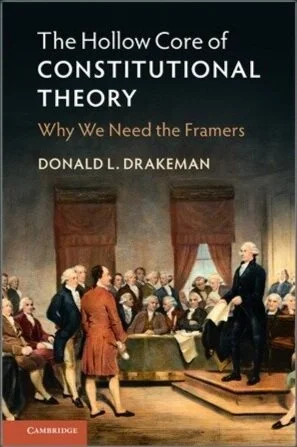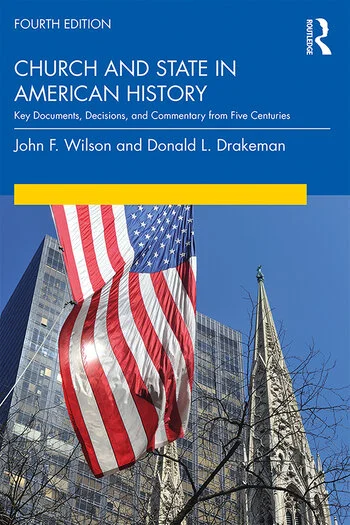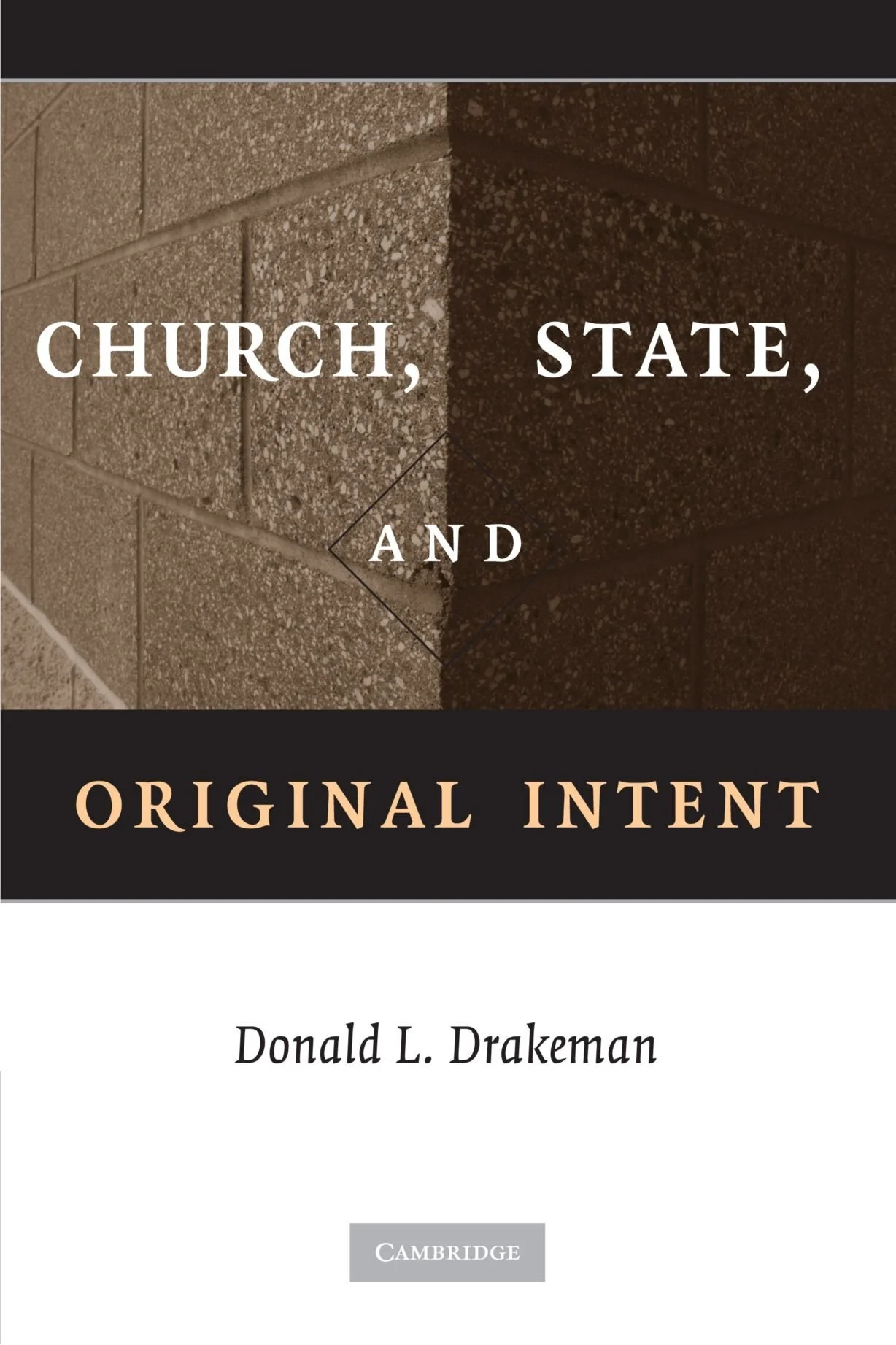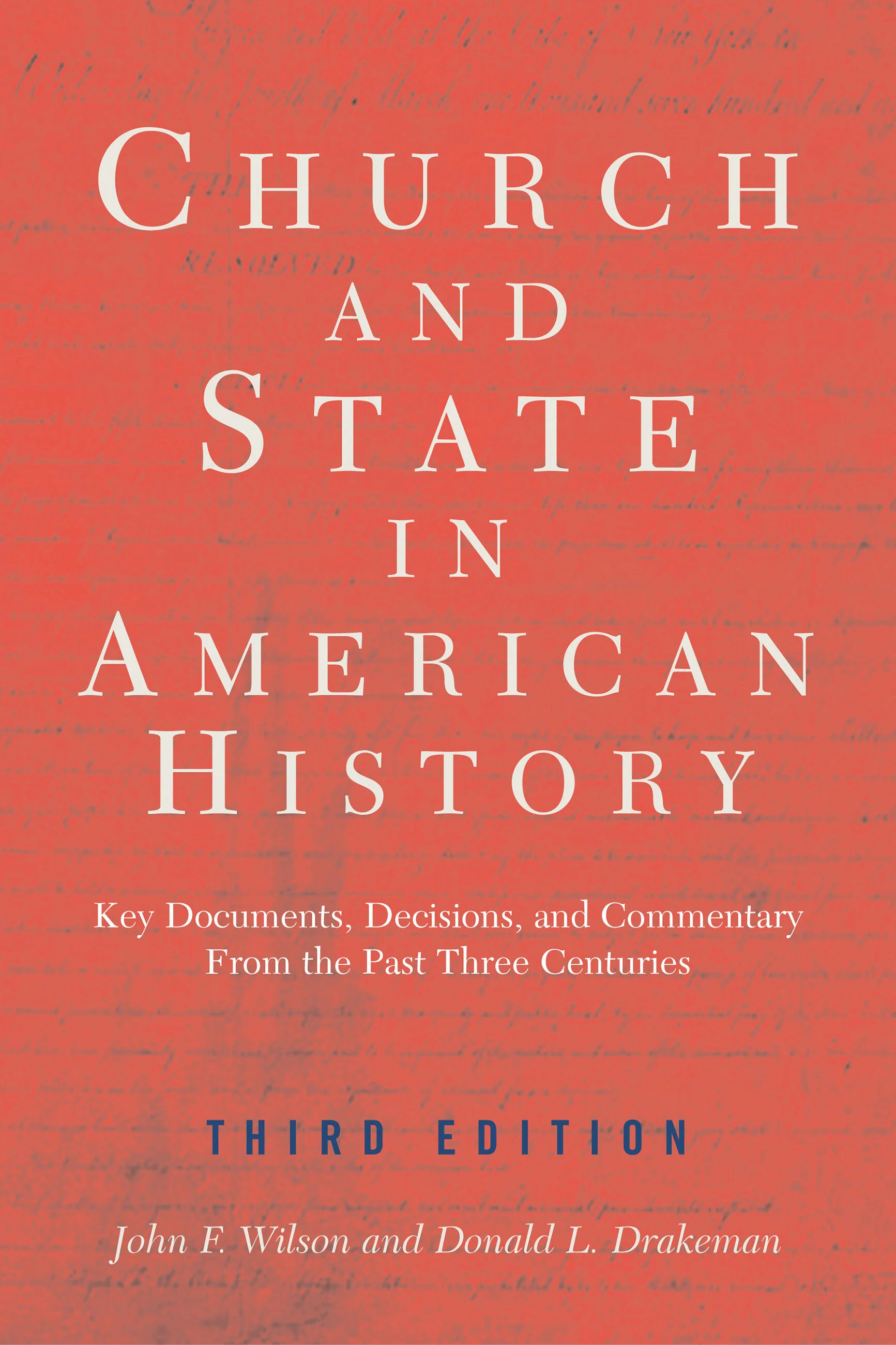Law, Religion, and Constitutional Interpretation
I am especially interested in areas where scholarly research can influence real life decision making. Many of my writings relate to the history of church-state interactions in America, and how competing views of that history have influenced the Supreme Court’s interpretation of the Constitution, as I discuss in Church, State, and Original Intent (CUP, 2010) and related books. That work, in turn, led me to delve more deeply into how judges have interpreted legal documents throughout history, culminating in my most recent book: The Hollow Core of Constitutional Theory: Why We Need the Framers (CUP, 2020).
Do Supreme Court justices really just call balls and strikes, or are the Court’s decisions merely politics by another name? When we read that judges are originalists or favor a living Constitution, it often seems to be just another way of saying that they are conservatives or progressives. Are these approaches to interpreting the Constitution simply different ways of using complex legal language to camouflage political preferences? Or does it actually mean something for the Court to interpret the Constitution?
Donald L. Drakeman *88, Distinguished Research Professor in the Program in Constitutional Studies at the University of Notre Dame, discusses why it is both possible and important for today’s justices to continue this longstanding legal tradition, and to resist calls to decide constitutional cases based only on the will of a majority of the Court.
Books
The Hollow Core of Constitutional Theory: Why We Need the Framers, Cambridge University Press, 2021.
The Hollow Core of Constitutional Theory is the first major defense of the central role of the Framers' intentions in constitutional interpretation to appear in years. This book starts with a reminder that, for virtually all of Western legal history, when judges interpreted legal texts, their goal was to identify the lawmaker's will. However, for the past fifty years, constitutional theory has increasingly shifted its focus away from the Framers. Contemporary constitutional theorists, who often disagree with each other about virtually everything else, have come to share the view that the Framers' understandings are unknowable and irrelevant. This book shows why constitutional interpretation needs to return to its historical core inquiry, which is a search for the Framers' intentions. Doing so is practically feasible, theoretically defensible, and equally important not only for discovering the original meaning, but also for deciding how to apply the Constitution today.
“Drakeman’s treatment and criticisms of constitutional theory - whether of originalism or non-originalism - are unfailingly fair and insightful. His arguments for incorporating the framers’ intent into constitutional interpretation today are historically rich and conceptually cogent. A penetrating book sure to be of great interest to the specialist and general reader alike.” - Marc O. DeGirolami, Cary Fields Professor of Law, St. John’s University School of Law
“Drakeman writes with clarity, wit, and power.” - Stephen B. Presser, Raoul Berger Professor of Legal History at Northwestern University School of Law
“The Hollow Core is a powerful brief written to academics on behalf of the public who want to know the Constitution’s meaning.” - Adam J. McLeod, Professor of Law at Faulkner University, Jones School of Law.
Illiteracy: Books with Benson, The Heartland Institute
Heartland’s Tim Benson and Donald L. Drakeman discuss how judges have historically tried to identify the will of the lawmaker in interpreting legal texts, how constitutional theory has drifted from this practice in both originalist and living constitutionalist interpretational theories, and why we need a return to the search for the Framers’ intentions.
The American Idea Podcast: Hosted by Jeff Sikkenga, The Ashbrook Center
Donald and Jeff talk about the dangers of the living constitution, the real role of judges in our democratic republic, and why interpreting the Constitution should matter to you!
Church and State in American History: Key Documents, Decisions, and Commentary from Five Centuries (4th Edition), Routledge, 2020.
Church and State in American History illuminates the complex relationships among the political and religious authority structures of American society, and illustrates why church-state issues have remained controversial since our nation’s founding. It has been in classroom use for over 50 years.
John Wilson and Donald Drakeman explore the notion of America as “One Nation Under God” by examining the ongoing debate over the relationship of church and state in the United States. Prayers and religious symbols in schools and other public spaces, school vouchers and tax support for faith-based social initiatives continue to be controversial, as are arguments among advocates of pro-choice and pro-life positions. The updated 4th edition includes selections from colonial charters, Supreme Court decisions, and federal legislation, along with contemporary commentary and incisive interpretations by modern scholars. Figures as divergent as John Winthrop, Anne Hutchinson, James Madison, John F. Kennedy, and Sandra Day O’Connor speak from these pages, as do Robert Bellah, Clarence Thomas, and Ruth Bader Ginsberg.
The continuing public and scholarly interest in this field, as well as a significant evolution in the Supreme Court’s church-state jurisprudence, renders this timely re-edition as essential reading for students of law, American History, Religion, and Politics.
Church, State, and Original Intent, Cambridge University Press, 2009.
This provocative book shows how the United States Supreme Court has used constitutional history in church-state cases. Donald L. Drakeman describes the ways in which the justices have portrayed the framers' actions in a light favoring their own views about how church and state should be separated. He then marshals the historical evidence, leading to a surprising conclusion about the original meaning of the First Amendment's establishment clause: the framers originally intended the establishment clause only as a prohibition against a single national church. In showing how conventional interpretations have gone astray, he casts light on the close relationship between religion and government in America and brings to life a fascinating parade of church-state constitutional controversies from the founding era to the present.
“In his splendid new book, Donald Drakeman storms into the breach once more with the provocative thesis that the Supreme Court’s rendition of the establishment clause has largely been a story of creation-myth making…. [H]e invites us to accompany him on an investigation, as objective as possible, of the historical record, which he argues indicates that the establishment clause was originally understood simply to forbid the establishment of a national church…. If in the beginning we were promised an investigation, we actually end up with a tour de force.” – Kody W. Cooper, Review of Politics
“This volume should be of value to any scholar who has the least interest in historical research; it is a textbook example of how to approach an historical debate and dismantle it bit by bit through the scrupulous use of primary materials, well constructed argument, and a refusal to jump to conclusions that are not supported by the evidence.” - Eric Michael Mazur, Church History
“The most comprehensive, most authoritative, and simply put, the best book published to date on the original meaning of the Establishment Clause.” - Vincent Phillip Muñoz, Claremont Review of Books, 2010
Watch the panel discussion of Church, State, and Original Intent hosted by the James Madison Program at Princeton University October 8, 2010.
Church and State in American History: Key Documents, Decisions, and Commentary from the Past Three Centuries (3rd Edition), Routledge, 2003.
Provides the key source materials for historical and legal understanding the relationship of church and state.. The controversies surrounding aid to parochial schools, blue laws, school prayer, and birth control programs have been central to the ongoing search for the proper boundary between religious and political authority in America. This concise volume features chronologically organized selections from such official documents as colonial charters, court opinions, and legislation, along with incisive twentieth-century interpretations of the issues they treat. Historical figures as diverse as John F. Kennedy, Perry Miller, Reinhold Niebhur, and Paul Blanshard, together with contemporary ones illuminate the interrelationships between the legal, political, and religious structures of American society. We encounter controversies every day that concern school vouchers, prayer in schools and stadiums, religious symbols in public spaces, and tax support for faith-based social initiatives as well as arguments among advocates of "pro-choice" and "pro-life" positions. These and other issues are at the center of an ongoing search for a means to delineate the interactions among religious and political authorities — initially in the United States but increasingly in the rest of the world as well.
This concise volume presents chronologically-organized chapters that include selections from documents like colonial charters, opinions of the Supreme Court and salient legislation, along with contemporary commentary, and incisive interpretations of the issues by modern scholars. Figures as divergent as John Winthrop, John F. Kennedy, and Sandra Day O’Connor speak from these pages as directly as Paul Blanshard, Reinhold Niebuhr, John Courtney Murray, and Robert Bellah. Church and State in American History addresses the difficult relationships among the political and religious structures of our society and the emergence of an American solution to the church-state problem.
Church-State Constitutional Issues: Making Sense of the Establishment Clause, Greenwood Press, 1991.
Church-State Constitutional Issues explores the often-debated and always topical issue of the relationship between church and state as outlined in the First Amendment. Donald L. Drakeman takes an interdisciplinary approach to examine the meaning of the establishment clause, demonstrating how the studies of law, religion, history, and political science provide insight into this relationship, which, since the nation's inception, has been difficult to define.
The study first chronicles the Supreme Court's decision regarding the interpretation of the establishment clause from the early 19th century to the present. This legal history is subsequently viewed from a cultural perspective as Drakeman traces both the background of the First Amendment and how the relationship of church and state has developed on its journey through the court system. The volume moves towards further understanding of this complex issue as it concludes with a new interpretation of the establishment clause derived from previous information as well as further legal and political interpretive material.
Church and State in American History: The Burden of Religious Pluralism, 2nd Edition, Beacon Press, 1987.
The controversies surrounding aid to parochial schools, “blue laws,” school prayer, and birth control programs have been central to the ongoing search for the proper boundary between religious and political authority in America. This concise volume features chronologically organized selections from such official documents as colonial charters, court opinions, and legislation, along with incisive twentieth-century interpretations of the issues they treat. Figures as diverse as John F. Kennedy, Perry Miller, Reinhold Niebuhr, and Paul Blanshard illuminate the interrelationships between the legal, political, and religious structures of American Society.
Recent Articles
Is Corpus Linguistics Better than Flipping a Coin? Donald Drakeman, Georgetown Law Journal Online, Volume 109, Summer 2020.
Corpus linguistics offers the promise of “Big Data” solutions to difficult issues of constitutional interpretation. By searching the millions of words in COFEA, the Corpus of Founding-Era American English, scholars have reached what they have described as rigorous, reliable, and reproducible conclusions about the original meaning of the Constitution. These conclusions rely on unexamined assumptions about the nature of the database and the reliability of the methods employed for interpreting the data. This Article is the first to analyze those assumptions, and it shows why digital searches in COFEA are unlikely to be more accurate than flipping a coin. An understanding of these methodological assumptions will enable researchers to make the necessary adjustments to increase the odds of success in the future
Which Original Meaning of the Establishment Clause is the Right One? in Breidenbach and Anderson, eds., The Cambridge Companion to the First Amendment and Religious Liberty, Cambridge University Press, 2020.
Debates over the original meaning of the establishment clause have usually revolved around the question of which broad church-state principle is represented by the clause. Strict separationists advocating a “wall of separation” highlight different historical evidence than do non-preferentialists who argue that the clause allows evenhanded government support for religion. A third group asserts that the clause was instead a federalism provision designed to reserve church-state decisions to the states. This chapter assesses these conflicting interpretations and concludes that the framers and the public understood the clause only as banning the establishment of a national church. That understanding did not necessarily represent an anti-establishment principle, however, and it assumed that church-state issues would continue to be resolved by the states. In light of the Supreme Court’s adoption of the incorporation doctrine, the combination of the federalism interpretation and the no-national-religion prohibition best encompasses the original constitutional decision.
James Wilson in Dreisbach and Hall, eds., Great Christian Jurists in American History, Cambridge University Press, 2019.
James Wilson, born in Scotland and educated during the Scottish Enlightenment, became one of the most influential jurists and statesmen of the American founding era. He signed the Declaration of Independence, served as an influential delegate to the Constitutional Convention, became one of the first justices of the U.S. Supreme Court, and was the first law professor at the University of Pennsylvania. As a framer, jurist and educator, he consistently argued for recognizing the sovereignty of the people themselves, which he believed was a central component of a God-given natural law. Many of Wilson’s views that were innovative or controversial at the time – such as the concepts of popular sovereignty, one person-one vote, and the power of the Supreme Court to strike down unconstitutional laws – have become important elements of modern American government.
Consequentialism and the Limits of Interpretation: Do the Ends Justify the Meanings?, Jurisprudence: An International Journal of Law and Political Thought, Volume 9 Issue 2, 2017.
A recent consequentialist resurgence in transnational legal scholarship urges judges in cases involving authoritative texts to make decisions based on which outcomes will be best for society. Some consequentialist scholars assert that judges should openly disclose these reasons, while others advocate replacing them with any plausible argument employing the traditional language of interpretation. This article argues that making consequentialism the primary basis for judicial decision-making runs counter to the long history of legal interpretation, is contrary to the insights of modern decision science, and raises significant separation of powers issues, even when it is fully disclosed. Covert consequentialism is even less likely to lead to good consequences, and it poses substantial threats to both the separation of powers and the rule of law.
Constitutional Counterpoint: Legislative Debates, Statutory Interpretation and the Separation of Powers, Statute Law Review, Volume 38 Issue 1, 2017.
Critics have raised concerns that Pepper v. Hart’s relaxation of the exclusionary rule relating to Parliamentary debates in Hansard has created separation of powers issues by attributing statutory meaning to ministerial statements. This article argues that, in some cases, the absence of references to Hansard also has the potential to lead to separation of powers concerns, especially where citing Hansard could blunt criticism that the U.K. Supreme Court has exceeded its proper role in statutory interpretation.
Charting a New Course in Statutory Interpretation: A Commentary on Richard Ekins’ The Nature of Legislative Intent, Cornell Journal of Law and Public Policy, 2014.
Jettisoned by many modern scholars, legislative intent is a critical component of statutory interpretation, according to a recent book by Richard Ekins. In what has been called the most philosophically sophisticated work on the subject of legislative intention, Ekins describes the well-formed legislature as a group agent that enacts laws based on coherent and reasoned plans that represent the legislature’s intent. In interpreting the laws, the duty of courts is to infer that intent, which requires judges carefully to consider the chain of reasoning that led to a particular legislative choice about means and ends. Professor Ekins thus charts a new course in the debates over statutory interpretation between textualism’s focus on semantic meaning and a much more openended purposivism. This Article sets out Ekins’ discussion of the central case of the well-formed legislature, and his compelling argument for courts to interpret statutes by inferring the reasoned plan adopted by the legislature and made known in the text. It then analyzes the opportunities and challenges arising in applying Ekins’ analysis to litigated cases and flesh-and-blood legislative bodies by focusing on how, and where, courts should look for evidence of that intent. It concludes that a thoughtful use of legislative history, though discarded by a great deal of contemporary scholarship, including Ekins’ work, can be an essential element of the search for a statute’s meaning.
What’s the Point of Originalism?, Harvard Journal of Law and Public Policy, 2014.
New originalism says that the Supreme Court should interpret the Constitution by focusing on the original public meeting of the text, not the Framers’ intentions. This article points out that one of the primary reasons for Supreme Court opinions is to persuade the public that its constitutional decisions are legitimate interpretations. Therefore, it is important to know what arguments are most convincing to the public. Using new survey data showing not only that over 90% of the public thinks the original meaning should play a role in constitutional decisions, but also that two-thirds cite the Framers’ intentions as the single most important source of that meaning, the article argues that, when the Court sets out to interpret the Constitution, the place to start is with Framers.
The Antifederalists and Religion in Faith and the Founders of the American Republic, Mark D. Hall and Daniel L. Dreisbach, eds., Oxford University Press, 2014.
Even before the founders were dead and buried, the American public had developed an extraordinary curiosity about their faith commitments (or lack thereof) and the influence of religion on the constitutional republic they established. This fascination has waned little over the last two centuries. Studies of religion and the founding fathers typically focus on the beliefs of a handful of elite founders—Franklin, Washington, Adams, Jefferson, Madison, and Hamilton. With the exception of Adams, all these men either were or became Anglicans. As such, this scholarship ignores the rich range of religious traditions that informed the political culture of the American founding. Faith and the Founders of the American Republic addresses this shortcoming by offering essays on a variety of religious views and beliefs that shaped late-eighteenth-century public life, such as the contribution of evangelical denominations to advancing religious liberty. Thematic chapters consider minority faiths such as Islam and Judaism, as well as major traditions such as Calvinism. The volume also includes chapters on specific founders carefully selected because they shine light on specific faith communities and/or ideas. Chapters on John Dickinson and Isaac Backus/John Leland, for instance, offer insights into the role of Quakers and Baptists respectively in the founding era. The essays collected in this volume provide compelling evidence that diverse religious traditions were among the intellectual sources that informed and animated the American founding.
The Limits of New Originalism, Joel Alicea and Donald L. Drakeman, University of Pennsylvania Journal of Constitutional Law” (2012-13).
We argue that New Originalism, which has emerged as the dominant theory of originalism, has a significant methodological limitation for anyone who takes historical research seriously. That limitation arises where historical sources indicate different possible original meanings, which can occur because of New Originalism’s focus on the meaning of the text for a hypothetical, reasonable person at the time of ratification. We describe the first instance of this problem, which occurred in Hylton v. United States (1796). Hylton involved the constitutionality of an excise tax, and we use that case to provide a real example of the impossibility of a New Originalist interpretation when the historical materials provide clear evidence of equally plausible but conflicting meanings. We suggest that Justice Paterson's opinion in Hylton offers a solution to this problem: where New Originalism cannot settle the question of original meaning, judges might turn to Old Originalism's focus on the intentions of the Founders. Our article thus makes three significant contributions to constitutional scholarship: (1) it identifies a critical weakness of New Originalism; (2) it demonstrates how the Supreme Court in the founding era used Old Originalism to resolve this problem; and (3) it represents the most complete analysis of the historical meaning of the taxation provisions in Hylton, which may prove to be useful for present or future litigation over the taxing power.



















